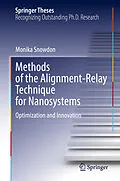This thesis addresses the problem of improving the alignment of carbon nanotubes (CNTs) in transistor applications, taking a unique approach using iptycenes acting as molecular tweezers in combination with a liquid crystal solvent. As part of a project to test the effectiveness of a multi-step method, the so-called Alignment Relay Technique (ART), this work contributed evidence for the selectivity and stability of ART, as well as providing the first proof-of-concept that ART can be used to create CNT field-effect transistors (FETs). The thesis effectively explains and illustrates the chemical synthesis of the tweezers, the concept and actualization of the technique, the various factors observed to influence deposition and selectivity, along with material fabrication using both photolithography and electron beam lithography. This research advances knowledge of transistors and expands the applications of small organic molecules in the field of materials science. Particular highlights of this thesis include: an extensive review of ART, its advantages, and limitations; development of new material chemistry methods for the optimization of semiconducting CNT selectivity; and a comprehensive exploration of fabrication and characterization of CNTFETs for future applications.
Autorentext
Monika obtained her doctorate in chemistry from the University of Waterloo, Canada. Part of her doctoral research was pursued in Japan at the soft materials chemistry group under the supervision of Dr. Dai-Ming Tang at the National Institute for Material Science. She holds a MSc in organosulfur synthesis and a BSc in nanoscience from the University of Guelph, Canada. Currently, she is a postdoctoral researcher in mechanical engineering at Dr. Zhou's lab as part of the Center for Advanced Materials Joining, University of Waterloo, and a lead product developer with Elizion Tech.
Inhalt
Table of Contents
Examining Committee Membership ....................................................................................................... ii
Author's Declaration .............................................................................................................................. iii
Statement of Contributions .................................................................................................................... iv
Abstract .................................................................................................................................................. v
Résumé ................................................................................................................................................. vii
Acknowledgements ............................................................................................................................. viii
Dedication ............................................................................................................................................. ix
List of Figures ..................................................................................................................................... xiv
List of Tables ..................................................................................................................................... xxiv
List of Equations ............................................................................................................................... xxvi
List of Schemes ................................................................................................................................ xxvii
List of Abbreviations ....................................................................................................................... xxviiiLand Acknowledgement .................................................................................................................... xxxi
Tribute to Nanotubes ........................................................................................................................ xxxii
Chapter 1 : Introduction.......................................................................................................................... 1
: Background and Literature Review ............................................................................................ 3
Primer on Carbon Nanotubes ................................................................................................ 3
Fabricating Carbon Nanotubes ............................................................................................ 10
Carbon Nanotube Defects .................................................................................................... 19
Carbon Nanotube Electronic Properties .............................................................................. 21
Carbon Nanotubes as Transistors ........................................................................................ 27
Carbon Nanotube Sorting .................................................................................................... 33
Carbon Nanotube Alignment ............................................................................................... 36
Carbon Nanotube Alignment and Sorting ........................................................................... 41
Alignment Relay Technique ....................................................................................................... 44
Intermolecular Interactions with SWNTs ............................................................................ 44
Substrate Binding ................................................................................................................ 47
Surface Oxidation and Cleaning .......................................................................................... 49
Liquid Crystal Technology .................................................................................................. 51
Synthesis of the CNT Tweezer in ART ............................................................................... 54
ART Process ........................................................................................................................ 55
xi
Characterization methods ........................................................................................................... 58
Atomic Force Microscopy ................................................................................................... 58
Scanning Electron Microscopy ............................................................................................ 61
IR and Raman Spectroscopy ............................................................................................... 64
I-V Testing........................................................................................................................... 71
Additional Techniques ......................................................................................................... 77
Concluding Remarks .................................................................................................................. 80
Chapter 2 : Modifications to the ART Procedure ................................................................................. 81
Post-Carbon Nanotube Deposition: Sonication .......................................................................... 81
Results and Discussion ........................................................................................................ 82Summary of Sonication Experimen…
